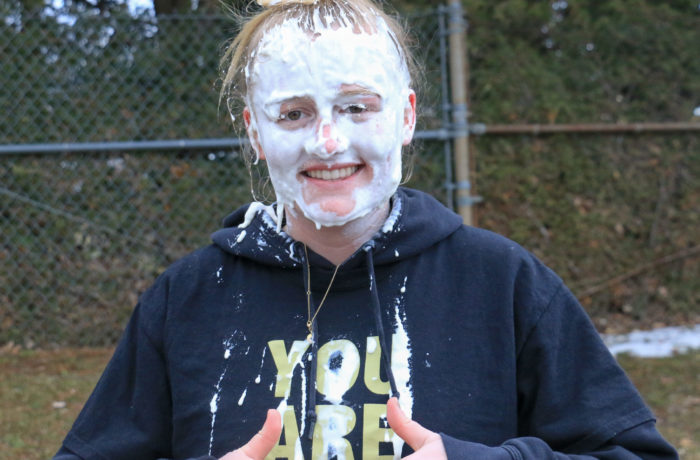 Tension has been high this spring in the admissions office at St. Michael’s College. Rising costs of higher education, along with a declining pool of students in New England, has hit the smaller colleges of this region particularly hard, and St. Michael’s is no exception. The postmark deadline for enrolling 2017-18 students to send in deposits was May 1. Online deposits have been submitted and mailed deposits are still rolling in. And the numbers reveal much about the future of the college.
Tension has been high this spring in the admissions office at St. Michael’s College. Rising costs of higher education, along with a declining pool of students in New England, has hit the smaller colleges of this region particularly hard, and St. Michael’s is no exception. The postmark deadline for enrolling 2017-18 students to send in deposits was May 1. Online deposits have been submitted and mailed deposits are still rolling in. And the numbers reveal much about the future of the college.
“It’s been a flurry of activity over the weekend,” said Sarah Kelly, vice president of enrollment at St. Michael’s as of May 2. “I’m not going to give you an exact number, but we feel we are on pace to reach our budget goal. The number changes by the hour.”
The “budget goal” for enrolled first year students for the 2017-18 school year is 489, Kelly said.
There is intense competition for students among the competitor colleges, who have gone to their wait lists, Kelly said.
Challenges for colleges are many and one critical element is that there is a decline in high school students in New England, which means there are less eligible students for colleges to recruit, especially from private Catholic schools, the main pool of students from which St. Michael’s recruits year after year. Foreseeing this trend, St. Michael’s has decided to reduce the student body to 1,600 students.
“Given the decrease in demographics of the Northeast, the declining birth rates in the Northeast, these are the realities,” Kelly said.
Seventy percent of college students stay within a 200 mile radius of their homes, according to a study in the 2009 Journal of College Admissions. With Canada as our Northern neighbor, that exacerbates the problem, Kelly said. The northeast is seeing a 9.5 percent decline in high school graduates, while there are 515 colleges in the Northeast competing for those students.
To add to the challenges, Kelly said, high school students are applying to between seven and 10 colleges, a greater number than ever before. “That automatically increases competition and makes it more difficult to get students. It’s not really wanting to be 1,600, it is making sure that if the demographics are not in our favor, the competition is not in our favor, we are okay.”
This does not necessarily mean aiming for future class sizes of 400 students. Getting the right amount of students means taking into consideration the retention rate because not every student who commits to St. Michael’s comes and not every student stays all four years.
Though the retention rate of students hovers around 90 percent year to year, which is good according to Kelly.
Right now there are two major problems facing higher education in New England – a decrease in potential students and increased competition between colleges – according to Kelley. This dilemma comes at a crossroads of a rebranding strategy for the school.
“What I do see for a while at least is being a little smaller because one of the things we don’t want is to anyway lessen the perceived quality of the college,” said President Jack Neuhauser. “Strategically that would be a mistake, it is hard to recover from that.”
Four times 500 equals 2,000, right?
Take last year, for example, where the incoming class was just under 500 students. If all the classes are around 500, then wouldn’t that mean about 2,000 students?
“It’s not 500 times four because they don’t stay,” Kelly explained. With about a 90 percent retention rate that means about 450 students are staying past their first year. Students might not graduate in four years, some students may transfer and some may transfer in and some students have AP credits, sometimes allowing them to graduate earlier. Therefore to keep the student body at 2,000 you would want more than 500 entering their first year in the fall.
“We are planning for right around 500 students” Kelly said. “It’s not where we budget for though, because that would be kind of derelict of us to budget for that then have all of these crazy things happen.”
I like St. Mike’s
The last time St. Michael’s re-branded, was in 2010. St. Michael’s current tagline is “I like St. Mike’s.” The emphasis was on the happiness of students, but after brand testing, the college realized the messaging was not showcasing the full academic side to St. Michael’s, according to Kelly.
Student demographics have been shifting in recent years as well. The most recent classes have gone up in academic standing over the past few years. SAT scores have been steadily increasing for accepted students, 20 percent of last year’s accepted students were eligible for the honors program and 49 percent were from the top 25 percent of their graduating class. The number has steadily increased, according to Kelly.
“When you get better, your ranking goes up and now we are top 100, we are 99th in the country in liberal arts, which is big,” said Kelly.
Students who perform better academically are also more likely to travel, according to Kelly. Thus, recruiting efforts have been stepped up in areas such as California, Colorado, Illinois, Florida, Maryland and Virginia where the high school student population is growing, said Michael Stefanowicz, director of admissions.
Bracing for the long term
Like all New England colleges, St. Michael’s has anticipated and planned for a declining number of high schoolers in New England.
In 2013-2014 St. Michael’s put together the Strategic Assessment Task Force (SAT), a group of faculty, staff, administration and Board of Trustee members that looked at trends in higher education that would be relevant to the college. This committee delved into the prospects of enrollment in New England because that is where the college mainly gets its students, giving their findings over to the administration to make the final decisions, said to John O’Meara, an SAT member and physics professor.
Beyond the physical numbers of high school population, overall the dynamics are shifting and a widening wealth gap is making it harder to afford college for large amounts of students, said Vince Bolduc, professor of sociology. He explained that it is often harder for low income students to go to more selective colleges and universities, like St. Michael’s. However, for-profit and community colleges have higher failure rates, so students who do enroll often don’t reap the benefits of a degree.
St. Michael’s is trying to change that. In April St. Michael’s joined the American Talent Initiative, promising to help recruit and enroll more low income students. 68 selective colleges with high graduation rates have been chosen to be part of the initiative.
The colleges are each promising to give the maximum financial aid, which St. Michael’s is hoping to do through fundraising.
Fundraising in the past few years has fallen short, but St. Michael’s hired in August 2016 a new vice president for institutional advancement, Richard Daniel, to move the college forward. “We are really tracking to meet and exceed our goal,” Daniel said, of the 20 percent alumni participation goal this year.
“The share of the population with a college degree by income at birth the gap is widening,” Bolduc said. “So, I’m delighted with this new program if it helps get more of the lower income individuals here because they are falling further behind while the higher quartile is pulling way ahead.”
As a small private college there will also be possible changes in St. Michael’s future to become more affordable for all families, especially when states like New York are offering free tuition to those making under a certain threshold.
“We can’t continue to be as expensive as we are for families,” Neuhauser said. “We have to figure out ways that can save families some money without changing who we are fundamentally.”
The problems for higher education and for small liberal arts colleges are not going to go away anytime soon. Rebranding and making the school smaller are two ways St. Michael’s is trying to be proactive, before it is too late.
“All problems are inherently very difficult to solve,” O’Meara said. “And it is very easy to look at one action that is part of a solution to problems and say that that action is just a terrible idea. I think it is important for everyone, the administration, the faculty, the students, the staff to remember that a college is a very, very complex ecosystem.”


